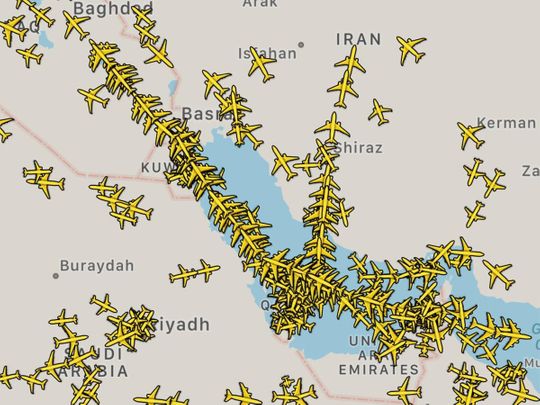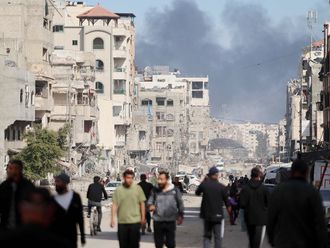
Washington: Update: The General Civil Aviation Authority (GCAA) has instructed national airlines to evaluate potential risks in areas that may endanger flight operations. GCAA recommended national carriers to take caution and be careful due to the current situation in the region.
In a statement issued on Wednesday, GCAA said it continues to assess and follow the situation and will take appropriate measures in due course.
Meanwhile, several major airlines said on Wednesday they were re-routing flights to avoid airspace over Iraq and Iran after the Federal Aviation Administration banned US carriers from the area following an Iranian missile attack on US-led forces in Iraq.
An Emirates spokesperson said, “Emirates flights EK 943 from Dubai to Baghdad and flight EK 944 from Baghdad to Dubai on 8 January have been cancelled for operational reasons.
“We are carefully monitoring the developments and are in close contact with the relevant government authorities with regards to our flight operations, and will make further operational changes if required.
“As always, the safety of our passengers, crew and aircraft is our number one priority and will not be compromised,” the spokesperson added.
A flydubai spokesperson also said, “flydubai has cancelled its flight later today to Baghdad. We are directly contacting passengers who have been affected. Our flights to Basra and Najaf this morning will operate. We are liaising with the relevant authorities and continue to monitor the situation closely.”
The FAA said it issued the airspace ban, which also includes the Gulf of Oman and the waters between Iran and Saudi Arabia, "due to heightened military activities and increased political tensions in the Middle East, which present an inadvertent risk to U.S. civil aviation operations."Air Canada, Singapore Airlines and Srilankan Airlines altered their routes to avoid Iranian airspace.
Several non-U.S. airlines had flights over parts of Iraq and Iran at the time, according to FlightRadar24 data. They are not directly affected by the FAA ban, but foreign carriers and their national regulators typically consider U.S. advice carefully when deciding where to fly.
Before the latest guidance, the FAA had already prohibited U.S. carriers from flying below 26,000 feet over Iraq and from flying over an area of Iranian airspace above the Gulf and Gulf of Oman since Iran shot down a high-altitude U.S. drone last June.
Carriers are increasingly taking steps to limit threats to their planes after Malaysia Airlines Flight MH17 was shot down in 2014 by a missile over Ukraine, killing all 298 people on board. Re-routing around conflict airspace adds to flight times and burns extra fuel.
- Air Canada was altering its routes
- Singapore Airlines Ltd all of its flights would be diverted from Iranian airspace
- Malaysia Airlines said it did not fly over Iraqi airspace and would re-route to avoid Iran
- Taiwan's China Airlines said it would not fly over Iran or Iraq
- Australia's Qantas Airways Ltd said it was adjusting flight paths
- Dubai-based Emirates Airline and flyduabi each canceled a return flight to Baghdad
- Korean Air Lines Co Ltd and Thai Airways avoiding Iranian and Iraqi airspace
- Air India, Air India Express flights to be temporarily re-routed
- In Germany, Lufthansa said it had halted overflights of Iran and Iraq until further notice
- Air France has decided to suspend all flights until further notice
- KLM has decided to suspend all flights until further notice
- Polish LOT, Swiss will also avoid the airspace
- Bahrein Airways and Kuwait Airways suspended flights to Iraq shortly after Soleimani's assassination; EgyptAir said it would as well, for three days
Iran struck back at the United States early Wednesday for killing a top Revolutionary Guard commander, firing a series of ballistic missiles at two military bases in Iraq that house American troops in a major escalation between the two longtime foes.
OPSGROUP, which advises airlines on security threats, said the new U.S. airspace bans were "significant", particularly given that the entire overwater airspace in the region is now unavailable.
"Flights headed to/from the main airports in the region such as Dubai will now need to route through Saudi Arabia's airspace," it said on its website.
An international aviation team has been activated to support "effective coordination and communication" between airlines and countries as tensions mount in the Middle East after a U.S. drone strike killed an Iranian military commander, global airlines body IATA said on Tuesday.
Airlines and the United Nations' aviation agency have started to monitor strategic airspace over Iran and Iraq. With some commercial carriers still serving those countries and others flying over their airspace, the International Air Transport Association also issued a statement reminding countries of their obligation to communicate potential risks to civil aviation.
"It is critical that states live up to this obligation as tensions in the Middle East rise," the group said, days after the killing of General Qassem Soleimani on Friday plunged the region into a new crisis.
The coordination team operated by IATA and the International Civil Aviation Organization (ICAO) was activated as a "standard precautionary measure," in the event that contingency measures are required by airlines, IATA said in a statement to Reuters.
The team brings together airlines, regulators and air navigation service providers to ensure any potential risks to aviation are shared quickly, an industry source familiar with the group said.








